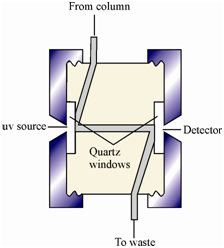Optical Detectors:
These include uv-visible spectrophotometers and are the most widely used ones in HPLC instruments. Three types of absorbance detectors are available;
- fixed wavelength (UV) detector,
- variable wavelength detector using deuterium lamp, and
- scanning wavelength detector.
These have noise limitations due to thermal instability in the flow cell and in the optical and electronic components. Thus, thermosetting to 0.01 oC is required as it may put noise limitation of 10-6 absorbance units. A quartz collimating lens focuses the radiation on the sample and reference cell with detector cell volume of 8µ L/cm optical path length. A schematic figure of a classical flow through cell for absorbance measurements in eluents is shown in Figure. A rise time of 0.1 sec is needed for fast HPLC measurements. It is necessary that the mobile

Figure: Schematic of an ultraviolet detector for HPLC system
phase solvent must not absorb or may absorb only weakly. Water, methanol, hexane and acetonitrile all permit operation in the for uv to at least 210 nm. Many absorbance detectors are double beam devices where one beam passes through the element cell and the other through a filter to reduce its intensity. Alternatively a chopped beam system in conjunction with a single phototube is used. Detection limit can be estimated if the noise level and the approximate molar absorptivity are known at the operating wavelength. Suppose 1 cm path length and a noise level of 0.00004 absorbance unit, detection limit is
2 (noise) / bε = 0.00008 / ε mol cm-1litre-1
If ε =10000, the minimum detectable concentration is 8 nM/L or 4 ng/mL for a compound having mol wt = 500. If it is needed in terms of sample weight instead of concentration, a sample volume and system dilution factor has to be considered. For 5µ L sample and a dilution factor of 20 (Mol wt 500), detection limit is given below
2(0.00004) 20 × (5 × 106 L) 500 /(10,000 L mol-1 cm-1)1cm = 0.4 ng